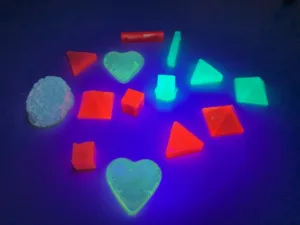Quantum dots are extremely small fluorescent nanoparticles typically between 10 to several thousand atoms, and 1 to 9 nanometers in diameter. The electronic characteristics of quantum dots are determined by their chemical composition, size, and shape. Quantum dots have the concept of energy level, bandgap, conduction band, valence band those are same as for normal bulk size material.
However, because of physical phenomenon called quantum confinement effect caused by their extreme small size, energy level of quantum dot become discontinuous and separated. This means that we can control the color of light given off by a quantum dot solely by changing its size. In general, bigger dots emit longer wavelength colors such as red, while smaller dots emit shorter wavelengths, such as green or blue. This means that light may be converted into nearly any color in the spectrum ranging from the UV to the IR region. Quantum dots also possess a very narrow half width and high quantum efficiency compared to ordinary solid fluorescent pigments, such that their applications could be
- Solar cells
- Display
- Medical devices, bioimaging (including the imaging of cancer cells, protein analysis, cell tracking, etc.)
- Quantum computers
- Security inks
- Quantum dot lasers
- LED
- Transistor
- Thermoelectric materials
- Artificial photosynthesis
And many other applications.
At present, there aren’t many quantum dots companies in the world. Quantum dots are generally supplied as dispersed nanoparticles in water or organic solvent so that they can be used as printing or coating materials. However, with this procedure, quantum dots have weakness such as poor lightfastness, as well as poor water and heat resistance, especially when they are printed or coated onto a substrate.
This time, Mr. Hirohisa Iwabayashi and Dr. Ryohei Mori at Green Science Alliance Co., Ltd. developed quantum dot + resin composite material which expected to possess higher resistance against light, water and heat because they are embedded in the resin. With this composite material, one can make any kind of shape and color by using any shape of mold, and various type of quantum dot which can emit various type of colors. They have been successfully developing quantum dot + resin, silica based inorganic composite material previously, although it was difficult to control the shape. It is the big progress that shape and emission color of quantum dot material can be controlled.
With this innovative quantum dot + resin composite material, it is suggested that application such as quantum dot display, solar cell, laser, LED, medical devices, bio-imaging etc… could be practical application faster.

